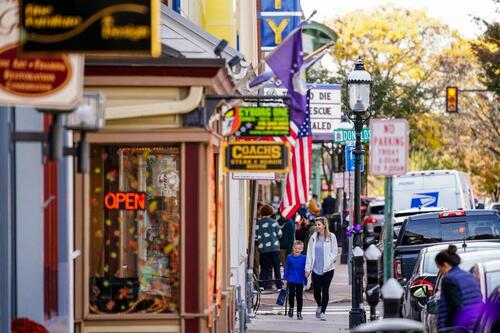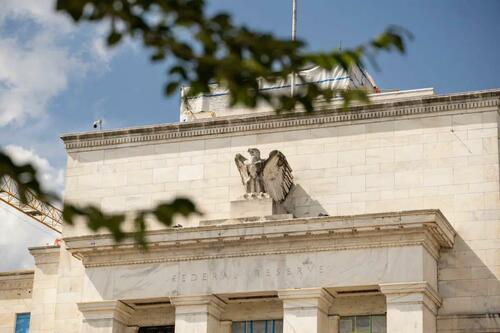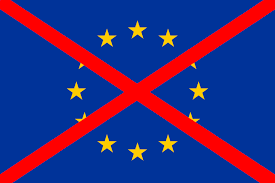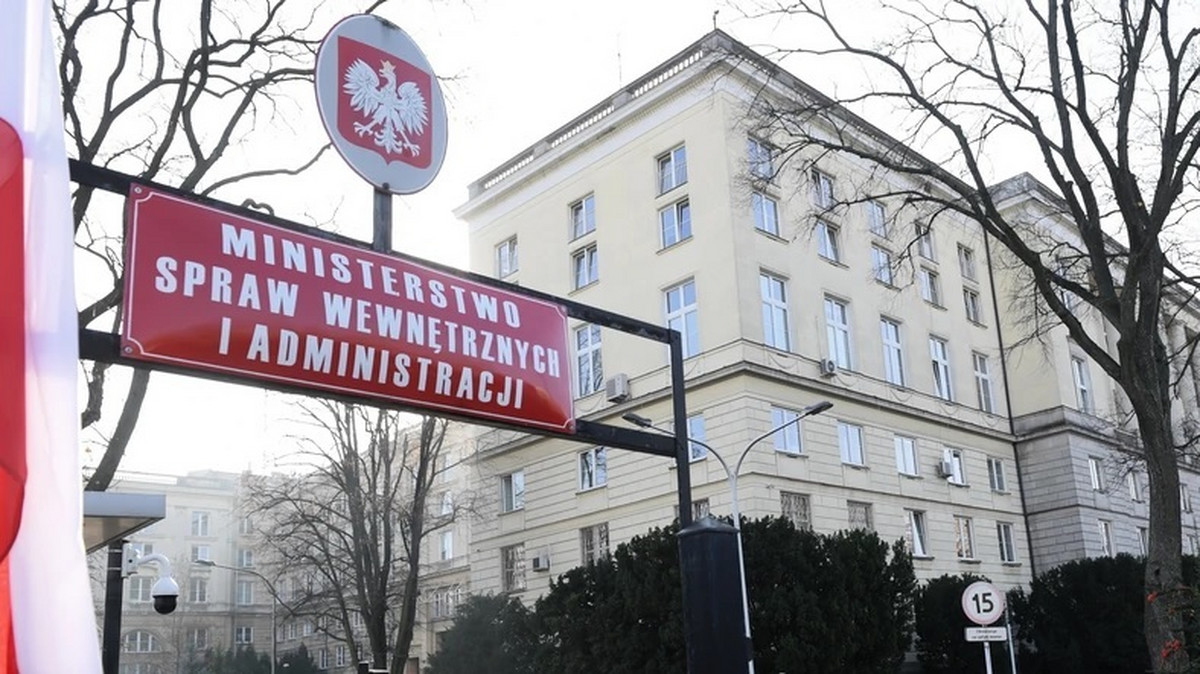
Small Business Lending Faces Mixed Signals Amid Economic Shifts
Authored by Andrew Moran via The Epoch Times (emphasis ours),
Small businesses in the United States encountered growing challenges accessing credit in June, according to Equifax’s latest small-business lending index.
 People walk past small businesses in Doylestown, Pa., on Nov. 4, 2021. Matt Rourke/AP Photo
People walk past small businesses in Doylestown, Pa., on Nov. 4, 2021. Matt Rourke/AP PhotoLending volumes fell by 3.3 percent month over month, although they remained up by more than 2 percent from the same period in 2024, according to the report released on Aug. 18.
The index’s three-month moving average jumped to 1 percent, fueled by robust lending activity volumes in April that have since eroded.
Regionally, 23 states experienced year-over-year declines in 12-month rolling lending volumes, with California (minus 10 percent), Nevada (minus 9 percent), and Georgia (minus 6 percent) leading the decline.
Across industries, nominal (noninflation-adjusted) lending decreased in six of the 17 sectors tracked. Accommodation and food services experienced the sharpest decline, while construction, finance and insurance, and retail lending remained stable.
Credit conditions showed signs of stabilization in the wake of President Donald Trump’s tariff agenda, the report reads.
The small-business delinquency index (31 to 90 days past due) edged up by nearly 2 percent, or three basis points, from May. The index was little changed from June 2024.
Additionally, the default index fell by more than 3 percent, down by seven basis points month over month.
Despite national improvements, 34 states reported year-over-year increases in default rates. Maine stood out with a 35 percent spike, the highest in the country. Delinquency rates rose or held steady in five industries, with wholesale trade posting the largest monthly increase of 2 percent.
In the coming months, a boost to small-business lending is expected to unfold in the third and fourth quarters.
Wall Street overwhelmingly anticipates that the Federal Reserve will lower interest rates beginning in September. The Fed’s periodic Summary of Economic Projections—a survey of policymakers’ expectations for the economy and interest rates in the future—points to two rate cuts this year.
The federal funds rate—a key policy rate that influences business, consumer, and government borrowing costs—has been unchanged in a target range of 4.25 percent to 4.5 percent since January.
However, although a rate cut is considered a boon for the credit industry, the report states that easing monetary policy could “exacerbate inflationary pressures.”
Last week, the annual inflation rate for July came in at 2.7 percent for the second straight month, lower than the market’s estimate of 2.8 percent. However, key pipeline inflation indicators—the producer price index and import prices—topped economists’ expectations, signaling that the current administration’s trade agenda could be igniting renewed price pressures.
The U.S. central bank will host its annual Jackson Hole Economic Symposium from Aug. 21 to Aug. 23, with Fed Chairman Jerome Powell delivering the keynote address on Aug. 22.
Lenders Signal Optimism
Despite the slowdown in small-business lending, a recent industry survey suggests that lenders remain optimistic, citing improved business conditions.
 The Federal Reserve in Washington on July 21, 2025. Madalina Kilroy/The Epoch Times
The Federal Reserve in Washington on July 21, 2025. Madalina Kilroy/The Epoch TimesAccording to the American Financial Services Association’s latest consumer credit conditions index for the second quarter, shared with The Epoch Times, the business environment was positive on balance.
In the April–June period, the net increasing index—a measure spotlighting the difference between the percentage of lenders who said loan performance conditions got better and those who said they got worse—reached the highest level in the survey’s six-quarter history.
In addition, 26 percent more respondents reported that funding costs improved in the second quarter than those who said they worsened. Meanwhile, 18 percent reported an improvement in the performance of their outstanding loans, compared with those who said it worsened.
Despite broad-based improvements, more auto lenders reported that business conditions weakened in the second quarter than those who reported improvements. Auto lenders also anticipate weaker overall conditions over the next six months.
Caution Ahead
Demand for loans from commercial and industrial companies has weakened, according to the New York Fed’s Senior Loan Officer Opinion Survey on bank lending. Banks, according to the report, also found weaker demand for credit and other loans from consumers.
Despite slowing credit demand, the findings indicated that credit supply through banking lending standards had not tightened significantly.
Bipan Rai, managing director at BMO, said that ultimately, the latest figures reveal both the good and the bad.
“Empirically, we know that a deterioration in the credit cycle is consistent with a general slowing of the real economy,” Rai said in an Aug. 11 note.
“A silver lining in the [Senior Loan Officer Opinion Survey] release is that credit supply … has not tightened materially. Typically, a slowing in the credit cycle would be more concerning if falling demand came as a result of tighter lending standards.”
Although the trade situation has stabilized since the April peak of uncertainty, businesses and consumers are seeking greater policy clarity, a recent survey highlighted.
The American Bankers Association’s latest credit conditions index—a quarterly outlook for credit markets—declined for the second consecutive quarter. The headline reading came in at 32.1—anything lower indicates expected deterioration—and the index fell to 35.7 for businesses and 28.6 for consumers.
Trade negotiations and passage of the One Big Beautiful Bill Act have offered some reassurance, but tariff-related uncertainty is still a headwind for credit conditions and the broader economy, according to Sayee Srinivasan, the association’s chief economist.
“’Hard data’ suggest the economy remains on solid footing, but consumer and business sentiment indicate that policy uncertainty remains elevated and is causing some firms and households to adopt a cautious approach to hiring, spending and investment,” Srinivasan said in the report.
The White House recently imposed higher reciprocal tariffs, ranging from 10 percent to 50 percent, on almost 70 U.S. trading partners. The president is expected to announce tariffs on imports of chips, semiconductors, and pharmaceuticals soon.
Still, small-business optimism has improved and is above the National Federation of Independent Business’s long-term average.
Bill Dunkelberg, the group’s chief economist, said that uncertainty persists but business owners are “reporting more positive expectations on business conditions and expansion opportunities.”
Tyler Durden
Tue, 08/19/2025 – 10:40















